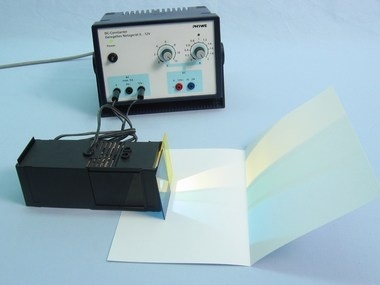Principle
In this experiment the students have the opportunity to investigate the possibility of subtractive colour mixing, which is based on the different spectral absorption of filters. In this way, they become acquainted with the second technically important process of colour production. A prerequisite for the understanding of the process is knowledge of the colour dispersion of white light, which is thus reviewed and extended. The subjective colour impressions seen in the preliminary experiment (looking through a yellow filter or a colour filter combination out of a window) can be discussed analogously and should mediate an understanding of the similarity between white light from an electric light bulb and the light emitted from the sun.
In one part of the experiment, the students investigate the possibility of observing three different colours producedby the partial overlapping of two colour filters on a screen. In this way, the path is preparedfor understanding the question posed at the beginning. Nevertheless, the further photographic procedure in colour positive development (reversal process and the use of subtractive light copy control) is relatively difficult for the students to follow, and an explanation should therefore only be offered if the interest exists.
The explanation of the colour impression from dark to black produced by colour filters, one behind the other, serves to illustrate the concept of absorption.
Benefits
- Multifunctional light box - All-in-one: Can be used for geometric optics on the table, colour mixing and on an optical bench
- Extension with others sets at anytime, no additional light sources needed, recognition value for students
Tasks
Why is a colour negative so different from the original? Investigate which colour impressions arise when different combinations of colour filters are placed in the path of the light box.


